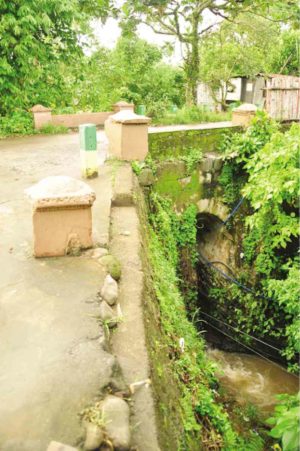10 more Spanish-era bridges added to protection list

The Spanish-era Puente de Baawin and other small bridges in Tayabas City have also become the focus of Oplan Sagip Tulay, a heritage protection group in Quezon. —CONTRIBUTED PHOTO
LUCENA CITY—At least 10 more stone bridges built during the Spanish colonization of the Philippines have been added to a list of old bridges that a local heritage group wants the government to protect.
The bridges, all in Tayabas City, had been left to the elements.
Oplan Sagip Tulay (OST), formed last year and is waging a battle to preserve the bridges, had earlier been victorious in efforts to preserve 12 primary Spanish-era stone bridges.
Of the 10 bridges added to the OST list, six had been identified as Puente de Baawin, Puente de Baguio, Puente de Calumpang, Puentecito de Malao-a, Puentecito de Putol and Puente de Ubli.
OST is still trying to determine the names of the four other bridges.
Article continues after this advertisementThe small bridges measure 2 to 4 meters long and have been built across creeks on roads leading to Sariaya town.
Article continues after this advertisementAdobe structures
John Valdeavilla, local historian and founding member of OST, said the structures were made of adobe and river stones.
“All of them have cracks. Most of the stones had been chipped off,” said Valdeavilla in an online interview about results of an ocular inspection made by his group on the 10 bridges.
The bridges, Valdeavilla said, had been built in the 1850s around the same time that the bigger bridges were built.
Natives helped build the bridges in lieu of paying taxes to the colonial government, according to historical records.
Tayabas is the only place in the country with a number of Spanish-era stone bridges still intact. Most are still being used by motorists and connect Tayabas to Sariaya, Lucban and Pagbilao towns.
Valdeavilla said OST had not included the 10 smaller bridges at the group’s launch in March last year because the group wanted immediate help to preserve the 12 bigger bridges.
Rotting treasures
“The 12 main bridges have already been declared as national cultural treasures and yet they are deteriorating,” Valdeavilla said.
“We have to move fast to save them,” he said. The National Museum of the Philippines had declared the 12 bridges as national cultural treasures on Aug. 12, 2011.
The OST campaign to serve the centuries-old bridges had caught the attention of national government agencies and people of Tayabas.
Through OST, a road-widening project on Maharlika Highway that would have destroyed one of the bridges, Gibanga, had been stopped.
To sustain the campaign, OST and residents are working together to clean the bridges and raise awareness.
Cleanup drives
On May 27, 500 people, mostly students, out-of-school youths, drug patients, policemen, government and private employees, helped clean up the grandest of the Spanish-era bridges—Puente de Malagonlong.
Last month, OST and the Tayabas City government also sponsored a photo and painting contest on the Malagonlong Bridge.
Tayabas City, 150 km southeast of Manila, was established in 1578 by two Franciscan missionaries.
From 1779 to 1910, Tayabas was the capital town of Quezon province, which was then known as Tayabas.